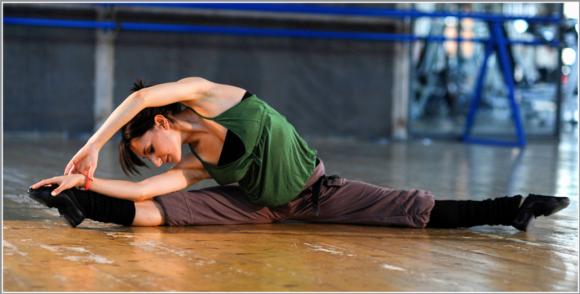Principles and Components of Cooling Down
This is an excerpt from Safe Dance Practice by Edel Quin,Sonia Rafferty,Charlotte Tomlinson.
The purpose of a cool-down is to gradually return the body to its normal functioning; again the key word here is ‘gradually'. Often the progressive intensity of a dance session means the highest physical intensity occurs at the end, which results in the dancer experiencing a high rate of blood flow around the body and a fast (sometimes near maximum) heart rate, with the metabolism and the nervous system in a heightened state of activity (see chapter 6 for more regarding the preferred versus the common intensities of session progression). To suddenly cease activity at this point is akin to slamming on the car brakes when you had been motoring along at full speed. Theory suggests that an effective cool-down can reduce injuries, in particular delayed-onset muscle soreness or DOMS (Harris & Elbourne, 2002; Laws, Marsh, & Wyon, 2006; Cheung, Hume, & Maxwell, 2003; Olsen, Sjøhaug, van Beekvelt, & Mork, 2012), and can promote enhanced performance for subsequent bouts of activity (Hindle et al., 2012; Rey, Lago-Peñas, Casáis, & Lago-Ballesteros, 2012). A focused cool-down is also thought to relieve any mental tension that may have built up during the dance session (Alter, 2004).
Regardless of dance situation (class, rehearsal, competition or performance), cooling down appears less popular than warming up (Laws, 2005; Koutedakis, Pacy, Carson, & Dick, 1997). Perhaps this is in part due to the limited amount of research that has been conducted on the benefits of cooling down and to the somewhat contradictory nature of the findings. Many of the research papers have focused solely on the stretching aspect of a cool-down. A 2002 systematic literature review noted that stretching after activity reduced muscular soreness for up to 72 hours after activity, although the authors comment that, due to a small effect size, these findings might not be strong enough to promote practical application (Herbert & Gabriel, 2002). A more recent review reported a literature consensus that static stretching post exercise can reduce muscle soreness for 24 hours after the activity (Herbert, de Noronha, & Kamper, 2011). However, stretching is only one component of the cool-down. Other research has examined the positive effects of including an active element (e.g., a pulse reducer) to the cool-down, reporting beneficial outcomes for subsequent power activities (Rey et al., 2012).
Review papers continue to note that the effectiveness of a cool-down, as with warm-up, appears to depend on the intensity, duration and relative dynamic or static nature of the content, the order in which the sections are conducted, as well as the specificity of the cool-down content to the activity that has just been experienced (Herbert et al., 2011; Rey et al., 2012). Despite such inconclusive recommendations, a statistical relationship can be seen between injury rate and cool-down: For example, dancers who cool down after their sessions report lower injury rates (Laws, 2005; Malliou et al., 2007). These findings support common theories that propose that effective cooling down can bring multiple physiological, neurological and psychological benefits that promote reduced injury risk and enhanced performance.
In order to effectively recover from strenuous dance activity, dancers and teachers must understand the physiological demands that the dance session has just targeted. Therefore, when choosing the specific focus of the cool-down, they should consider the type, level of intensity and duration of the activity that has just taken place (for more on these aspects, see chapter 4). For example, an Irish dance class has quite a high physical intensity, and predominantly targets activation of the calf (gastrocnemius and soleus) muscle group. It also subjects the lower limb joints to repetitive impacts. In planning the cool-down, Irish dance teachers must consider how to counteract these actions in order to effectively balance out or neutralise the accumulative effects of the activity on the dancing body. However, similar to warming up, before considering such specificity, dance leaders must be aware of the general principles of cooling down. These principles include reducing the pulse rate, easing out the joints and stretching the muscles. Once teachers have understood these ideas, they can and should adapt the principles as the need arises.

© Photoshot/TIPS
A dancer engaging in static stretching as part of her cool-down after class. This is after she has completed the pulse reducer and joint easing sections.
Example of Active-Static Stretching
Breathe in, breathe out and commence a stretch with control and attention, moving deeper into the position until the initial point of stretch sensation but not pain. Hold the position, mindfully relaxing any unnecessary tension, for around 10 seconds. Breathe in again. On the out breath, work to gently increase the stretch. Again hold this position for up to 10 seconds. If possible, gently increase the stretch once more on a third breath in and out. Using anatomical imagery can support an increase in ROM, especially if flexibility is currently restricted. Visualise making space in the joints and releasing the muscle fibres, even if no actual movement or increase in ROM is possible. Combining imagery with the breath helps reduce unnecessary muscular tension. Imagine increasing ROM and muscular length for the full duration of the stretch, even if you are not able to achieve any additional movement. Finish the stretch by maintaining the final position for approximately 20 seconds, and then gently ease the body out of the position.
Learn more about Safe Dance Practice.
More Excerpts From Safe Dance PracticeSHOP

Get the latest insights with regular newsletters, plus periodic product information and special insider offers.
JOIN NOW


